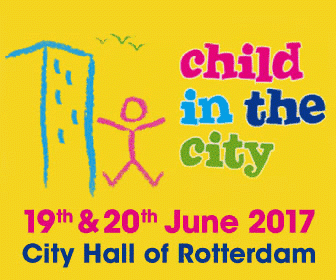
“Concrete outcomes and progressive agendas for children”
In this interview with the independent researcher and writer, Tim Gill, a speaker at the first Child in the City international seminar in Rotterdam next month, he highlights the need for cities to ensure real, practical benefits to children – not just ‘child-friendly’ processes – and how his forthcoming research aims to discover what motivates city leaders to adopt the kind of policies that will deliver them.
 What in your view defines a child-friendly town or city?
What in your view defines a child-friendly town or city?
A child-friendly city is one where children are healthy, active, engaged citizens who have the freedom to play and to get around the streets and neighbourhoods where they live, and who can gradually explore and enjoy the wider city as they grow up.
How important is the planning system in either supporting or compromising society’s responsibility for children’s rights?
Urban planning is crucial in shaping the fabric of the city, and hence children’s experiences of urban life. Planning can create walkable neighbourhoods that are on a child’s scale with safe streets, great green spaces and convivial squares. Or it can lead to car-dominated streets, neighbourhoods starved of green space and a dysfunctional or exclusive public realm.
What do you think are the major challenges for urban planners in relation to children and young people?
To quote Bogotá mayor Enrique Peñalosa, “The essence of the conflict today, really, is cars versus people… We can have a city that is very friendly to cars, or a city that is very friendly to people. We cannot have both.” This goes especially for children. Where planners give cars free rein, child-friendly measures like good walking and cycling networks and safe residential streets become almost impossible. But where traffic is tamed, children can enjoy more everyday freedoms and space can be liberated for people of all ages to enjoy.
What are the relative merits of some of the different approaches to developing and assessing child-friendly towns and cities?
The most well-known approaches have focused too much on processes – in particular, children’s participation – and not enough on outcomes. So cities can score well through setting up committees and running programmes, while leaving the bulk of the city unchanged for the majority of children. We don’t need to ask children what they want their cities and neighbourhoods to be like – they’ve told us too many times. We need to get decision makers to act.
We need approaches that focus on concrete outcomes for a city’s whole urban child population. Outcomes like the number of children who walk or cycle to school, or the proportion who live near to well-managed, playable green space.
So for instance, we should not be afraid of global league tables of child-friendliness. Of course different cities have different political, economic and social contexts. But children around the world want the same things from their cities. As advocates for children we should not be afraid to highlight where cities are failing them.
What does your own research suggest should be the priority for policymakers wanting to promote children’s rights in the public realm?
We do not know enough about why some cities have taken up child-friendly urban planning policies, while others continue to ignore them. My Winston Churchill Memorial Trust fellowship [link: https://rethinkingchildhood.com/2017/03/20/winston-churchill-trust-child-friendly-cities/] will explore what makes decision makers in cities like Rotterdam, Ghent and Vancouver put real momentum and energy behind a child-friendly vision for cities. Ask me this question again in a year or so, and I hope to have some answers!
What is your advice to children’s rights advocates aiming to make the case for child-friendly policies in planning and spatial development?
We need to build alliances with progressive urban agendas around transport and urban planning. Adults care about children, both as people today and as the citizens of tomorrow. By inviting adults to see cities through children’s eyes, we get them to move beyond their immediate personal concerns and instead to take a more long-term, less selfish view. This can help to strengthen the case for progressive policies that could otherwise face great resistance. And it can also influence those policies for the benefit of children. For example, we know that cities around the world are investing hugely in cycle infrastructure. As advocates we should be supporting this, and also pushing to make sure that the new facilities cater not only for fit 20-30-year old men, but also for beginner child cyclists and mums with toddlers in cargo bikes.
Interview with Adrian Voce
Tim Gill is an independent researcher and writer on children’s everyday lives and the changing nature of childhood, with a focus on children’s play and free time. His book No Fear: Growing up in a risk-averse society was published in 2007.
Photo: David Ebert
Tim Gill will be speaking at Urban Planning and Children, a Child in the City international seminar to be held in Rotterdam on 19-20 June 2017. More than fifteen speakers will present their insights and findings on Urban Planning and Children. Visit the conference pages here for more information and details about registration.





